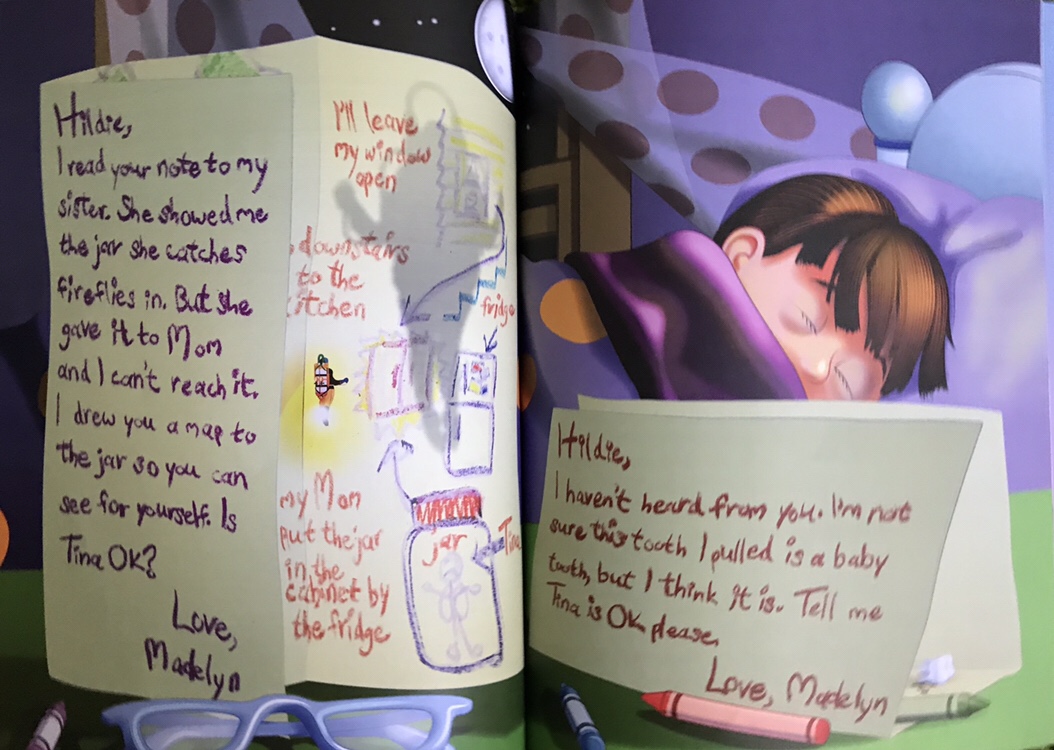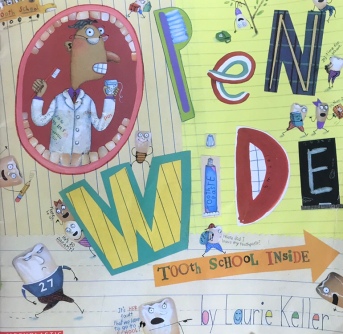This week we’re talking about teeth — their structure, function, care, and where they go after the Tooth Fairy visits!

Tooth Fairies and Jetpacks by Kurt Fried, illustrations by Patrick Meehan
Tooth Fairies and Jetpacks by Kurt Fried, illustrated by Patrick Meehan (Wonderstruck Press)
This scientific twist on the Tooth Fairy myth answers lingering pragmatic questions in a series of letters between two sisters and their assigned Tooth Fairies.
Madelyn has lost another tooth, but this time she wants a gajillion dollars and some fairy dust. After being informed that neither are real — tooth fairies use jetpacks — her curiosity leads to more questions. She learns that tooth fairies are a team scientists seeking the cure for human germ exposure using stem cells found in teeth.
Little sister Lydia is also curious about the Tooth Fairy. Eager to meet a real Tooth Fairy and unaware of the danger her germs create, she traps a novice fairy. All is resolved with clever guidance from Madelyn to her own Tooth Fairy in the form of a map. By the end, a lasting friendship and scientific exchange between the four is struck.
This is a charming tale perfect for young children filled with questions. Its storyline encourages inquiry and builds enthusiasm for science. And the characters’ technological skill, scientific knowledge, initiative, and agency make it an excellent modern counterpart to classic images of tutu-clad fairies. Overall, it would make an excellent addition to any library for young children expecting a visit from the Tooth Fairy.

Dear Madelyn: Thank you for the lovely incisor. To answer your questions, 1. I don’t use any fairy dust to fly, and so, no you can’t have any. 2. I use a jetpack. 3. And no, I won’t bring you a gajillion dollars next time. A gajillion isn’t a number. Yours always, The Tooth Fairy

Hi, But what are teeth for? Can I ride in your jetpack? My little sister hasn’t lost any teeth. Can you bring her something? Love, Madelyn. Dear Madelyn— Those are much more interesting questions. What do we do with the teeth? We study them. We’re scientists. All tooth fairies are. There are special things inside the teeth called “stem cells.” These cells can do cool things. I learn a lot from them. No, you can’t ride in the jetpack. It’s too small for you, and that’s one of the first rules we’re taught: no kids in jetpacks. It’s sweet to see you caring about your little sister. I left you an extra coin to give her. The Tooth Fairy

Hi Madelyn, I made a mistake. I shouldn’t have said anything about the fireflies. Now I can’t find Tina. I’m worried. I didn’t tell you why we study the teeth. Because of people germs. There are germs we get from people that make us get sick. We are trying to make medicine so we don’t get sick around people. That’s why we don’t let you see us, and that’s why we have you put the teeth under a pillow, so we stay away from your faces. If Lydia caught her, I’m afraid Tina will get sick. I’m looking everywhere, but if you see anything, let me know. Worried, Hildie

Hildie, I read your note to my sister. She showed me the jar she catches fireflies in. But she gave it to Mom and I can’t reach it. I drew you a map to the jar so you can see for yourself. Is Tina OK? Love, Madelyn. Hildie, I haven’t heard from you. I’m not sure this tooth I pulled is a baby tooth, but I think it is. Tell me Tina is OK please. Love, Madelyn

The Tooth Book: A Guide to Healthy Teeth and Gums by Edward Miller
The Tooth Book: A Guide to Healthy Teeth and Gums by Edward Miller (Holiday House; ages 5-8) is a comprehensive, eye-catching book covering all aspects of dental care.
Concise text paired with bold, graphic illustrations explains tooth growth/loss, anatomy, brushing/flossing, decay, dental visits, dietary influences on dental health, and first aid for dental problems/emergencies. Lists of daily dental care Dos and Don’ts then follow (e.g. Don’t bite hard objects; Replace your toothbrush every 3 months). For questions not answered in the book, a list of websites with additional information is included.
Lighthearted but confident in tone, I’ve found it helps allay toddler anxiety about dental visits in addition to building general knowledge. The guidance regarding routine hygiene and Dos/Don’ts is straightforward and easy for young children to remember. And the First Aid section makes it a uniquely valuable book for parents fearing accidents that knock-out or break permanent teeth. Overall, it’s an excellent choice for educating young children (and parents!) about their teeth.

PERMANENT TEETH The main reason you have teeth is to chew food into tiny pieces you can swallow. Each kind of tooth has a different job. INCISORS are the 8 teeth in the front of your mouth. They are for biting food. CANINES are the 4 pointy teeth. They are for tearing food apart. BICUSPIDS are the 8 teeth with 2 sharp points that crunch and shred food. Bicuspids replace primary molars. MOLARS are the teeth at the back of your mouth. They mash and grind food into tiny pieces. Everyone has a unique set of teeth. Just like your fingerprints, no 2 sets of teeth are the same.

BRUSHING The most important thing you can do to protect your mouth from tooth decay and gum disease is to keep it clean by BRUSHING with toothpaste and a toothbrush. Brushing cleans away food and plaque that sticks to your teeth and gums. HOW TO BRUSH 1. Squeeze this much toothpaste on your toothbrush. 2. Gently brush your teeth with small round strokes. Start from the back of your mouth and work your way around to the other side. DO NOT brush with up-and-down strokes because it can harm your gums. Make sure to brush all your teeth on all sides. Brush for 2 to 3 minutes.

DENTIST VISIST A DENTIST is a doctor for your teeth. He or she will check for cavities and gum disease and will repair any decayed or damaged teeth you might have. The dentist will take photos called X-RAYS of your teeth to look inside them for any decay. If you do have a cavity, the dentist will remove it. But first, he or she will place some special medicine next to your tooth. The medicine numbs the tooth so you won’t feel any pain. Once the medicine goes to work the dentist can remove the cavity with a small electric TOOTH CLEANER. When the cavity is out, the dentist fills the hole with a paste called a FILLING. The filling will quickly harden so you are ready to bite again.

Open Wide: Tooth School Inside by Laurie Keller
Open Wide: Tooth School Inside by Laurie Keller (Scholastic; ages 4-8)
Set in a school for teeth, this is a humorous approach to general dental education. Factual information covering tooth development, anatomy, hygiene, decay, and dietary influences on dental health is interspersed with numerous jokes and puns. The illustrations vary between educational graphics and humor-filled scenes of teeth behaving like typical school children. It then closes with True/False and Multiple Choice quizzes that reinforce key information.
Highly engaging while also informative, this is an excellent choice for older children who can pour over the detailed images, read the numerous speech bubbles, and appreciate the humor. For younger children the information regarding dental care is clear, concise and memorable even without fully grasping the humor. Overall, it’s a great choice for enhancing general dental knowledge.

Take your seats, everyone. I’m handing back your quizzes from yesterday on what healthy teeth should look like. I must say, I’m a little disappointed — the only teeth who passed are the wisdom teeth! We better go over this again. Shiny, clean teeth — GOOD. Holey, green teeth — BAD. Let’s move on. Here’s a look at what your teeth are made of: 1. When you’re in the gums, the part of you that shows is the CROWN. 2. You’re covered with a hard layer of ENAMEL to protect you from bacteria and germs. 3. DENTIN makes up the biggest part of you. It’s not as hard as enamel. 4. PULP is the softest part. It’s what hurts when you get a toothache. 5. The ROOT is what holds you in place. It’s protected by a thin layer of tissue called CEMENTUM.

Settle down teeth! You can’t go to Tooth Land — you’re needed here. Oh, come on. Don’t look so down in the mouth. We’re going to the School of Dentistry a week from Friday! But right now it’s almost time for lunch so let’s break up into our four groups. FOOD CUTTERS: Incisors FOOD TEARERS: Canines FOOD CRUSHERS: Premolars FOOD GRINDERS: Molars Way to go, class — get in there and EAT!

Well, well, well! It looks like you all had a good lunch. But to stay strong and healthy, it’s important to brush after meals. So what do you say we take out our toothbrushes and floss, and clean ourselves up? All right then, class. Since you don’t want to brush, why don’t we open our books to the chapter on TOOTH DECAY. Tooth decay is caused by bacteria. Bacteria like to eat sugar. Candy and cookies have one kind of sugar, and foods like fruit, bread, pasta, and milk have other kinds of sugar. Bacteria eat all kinds — especially those that stick to teeth. (Notice how some foods are not as sticky as they would seem to be.) NOT VERY STICKY: apples, bananas, hot fudge sundaes SORT OF STICKY: white bread, caramels, cream-filled sponge cake PRETTY STICKY: jelly beans, plain doughnuts, raisins SUPER STICKY: granola bars, oatmeal cookies, potato chips When lots of bacteria build up on teeth, that’s known as PLAQUE. Plaque eats right through enamel. And if plaque keeps eating, it means only one thing — A CAVITY!



Really annoyed at myself for not finding such books when my children were younger – have had so many tooth battles over the years #BlogCrush
LikeLiked by 1 person
To be fair, these were actually tough to find. There aren’t many books like this out there!
LikeLike
This
LikeLike
Sorry accidentally pressed post. This first looks just brilliant , there aren’t many science based tooth fairy books #blogcrush
LikeLiked by 1 person
Definitely unique 😊
LikeLike